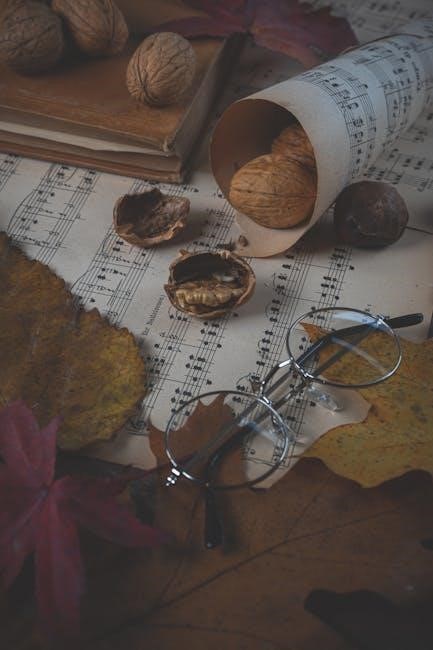“Autumn Leaves” is a timeless jazz standard, beloved by musicians and audiences alike․ Its rich harmonic structure and memorable melody make it a staple in jazz repertoire․ Sheet music PDFs provide convenient access to this classic, enabling performers to learn and interpret the piece with precision and creativity․ This resource is invaluable for both beginners and seasoned musicians seeking to master “Autumn Leaves․”
Popularity of “Autumn Leaves” as a Jazz Standard
“Autumn Leaves” has become a cornerstone of jazz repertoire, cherished for its timeless melody and rich harmonic structure․ Its versatility allows musicians to explore intricate improvisations while maintaining emotional depth․ The song’s enduring popularity stems from its adaptability across various instruments and styles, making it a favorite among jazz enthusiasts․ Composed by Joseph Kosma, with lyrics by Jacques Prévert, it has been interpreted by legendary artists like Miles Davis and Bill Evans, further cementing its status as a jazz standard․ The piece’s chord progressions, particularly the ii-V-I sequence, provide a foundation for learning and mastering jazz harmony․ Its widespread use in educational settings and performances highlights its significance in the jazz community, ensuring its continued relevance and appeal to new generations of musicians and audiences alike․
Why Musicians Search for Sheet Music PDFs
Musicians seek “Autumn Leaves” sheet music PDFs for their convenience and accessibility․ PDFs offer a digital format that can be easily downloaded, printed, or viewed on devices, making them ideal for practice, rehearsals, or performances․ Many musicians prefer PDFs because they are often free or low-cost, reducing financial barriers․ Additionally, PDFs allow for easy sharing and collaboration among band members or students․ They also provide a standardized format, ensuring consistency across different versions․ Some musicians appreciate the ability to customize PDFs, such as annotating parts or adjusting arrangements․ With the rise of digital music, PDFs have become a practical choice for learning and performing “Autumn Leaves,” catering to diverse skill levels and preferences․ This accessibility has made sheet music PDFs a go-to resource for musicians worldwide․
Overview of the Song’s Structure and Melody
“Autumn Leaves” is a jazz standard with a timeless structure and melody that captivates listeners․ The song follows a 32-bar AABA form, common in jazz, with a harmonic progression that transitions smoothly between chords․ Its chord changes, including the ii-V-I progression, provide a rich foundation for improvisation․ The melody is simple yet expressive, with a singable quality that makes it memorable․ The interplay between minor and major chords creates a bittersweet atmosphere, reflecting the song’s emotional depth․ Musicians appreciate the balance between structured harmony and melodic freedom, allowing for diverse interpretations; The melody’s phrasing and rhythmic nuances also offer opportunities for creative expression, making “Autumn Leaves” a versatile piece for both beginners and advanced players․ Its enduring appeal lies in its elegant simplicity and harmonic complexity, making it a staple in jazz repertoire worldwide․

History and Background of “Autumn Leaves”
“Autumn Leaves,” originally “Les Feuilles Mortes,” is a French song by Joseph Kosma and Jacques Prévert․ It became a jazz standard with Johnny Mercer’s English lyrics, captivating musicians globally․
Composition and Original Intent
“Autumn Leaves,” originally titled “Les Feuilles Mortes,” was composed by French musician Joseph Kosma, with lyrics by poet Jacques Prévert․ The song was first introduced in 1945 as part of a French film soundtrack․ Its original intent was to evoke a sense of melancholy and nostalgia, reflecting the fleeting nature of life and love․ The melody, with its haunting beauty, was designed to complement the poetic lyrics, creating a timeless emotional resonance․ Later, Johnny Mercer wrote the English lyrics, adapting the song for international audiences while preserving its core essence․ The composition’s harmonic structure, featuring a memorable chord progression, made it a natural fit for jazz interpretations․ This blend of poetic depth and musical sophistication has made “Autumn Leaves” a beloved standard across genres․

Evolution of the Song in Jazz Culture
“Autumn Leaves” transitioned from a French film song to a global jazz phenomenon, becoming a cornerstone of jazz repertoire․ Its rich harmonic structure and timeless melody made it a favorite among jazz musicians․ Pioneers like Miles Davis and Bill Evans popularized the tune, infusing it with improvisational brilliance․ The song’s chord progression, particularly its ii-V-I sequences, became a foundational study for jazz students․ Over the years, “Autumn Leaves” has been reimagined in various styles, from bebop to bossa nova, showcasing its versatility․ Its enduring appeal lies in its balance of melodic simplicity and harmonic complexity, allowing for endless creative interpretations․ Today, it remains a staple in jazz education and performance, bridging generations of musicians and audiences alike․
Notable Performances and Recordings
“Autumn Leaves” has been immortalized through iconic performances by legendary jazz artists․ Miles Davis’s rendition, featured on his 1956 album Blue Moods, is widely regarded as a definitive interpretation․ Bill Evans’s delicate piano solos and harmonically rich arrangements further elevated the song’s status․ Doris Day’s vocal version, though differing in style, remains a timeless classic․ Other notable recordings include those by Nat King Cole, Ella Fitzgerald, and Chet Baker, each bringing unique interpretations to the melody․ These performances have solidified “Autumn Leaves” as a jazz standard, inspiring countless covers and adaptations․ The song’s versatility is evident in its ability to transcend genres, from bossa nova to contemporary arrangements․ These recordings not only showcase artistic brilliance but also serve as invaluable resources for musicians studying the piece․

Benefits of Using Sheet Music PDFs
Sheet music PDFs offer unparalleled convenience, allowing instant access to “Autumn Leaves” arrangements․ They are cost-effective, environmentally friendly, and easily sharable, making them a practical choice for musicians worldwide․
Accessibility and Convenience
Sheet music PDFs for “Autumn Leaves” offer unmatched accessibility and convenience․ Musicians can instantly download and access the music from anywhere, eliminating the need for physical storage․ PDFs are compatible with various devices, including tablets, smartphones, and laptops, making them ideal for on-the-go practice․ Additionally, PDFs can be easily shared among band members or students, fostering collaboration․ The digital format also allows for quick searches and navigation within the document, saving time during rehearsals․ Moreover, PDFs are often printable, providing a tangible option when needed․ This level of flexibility ensures that musicians can engage with “Autumn Leaves” in a way that suits their preferences and workflow, whether they are professionals or hobbyists․ The convenience of PDFs has revolutionized how sheet music is accessed and utilized in modern music education and performance․
Cost-Effectiveness for Musicians
Sheet music PDFs for “Autumn Leaves” are a cost-effective solution for musicians․ Free downloads are widely available, reducing expenses for those on a budget․ Even paid versions are often affordable, offering high-quality arrangements at a fraction of the cost of physical sheet music․ This affordability makes it easier for musicians to access the music without financial strain․ Additionally, PDFs eliminate the need for shipping or handling fees, further saving money․ Many websites also offer bundled packages or discounts for multiple downloads, providing even greater value․ This cost-effectiveness is particularly beneficial for students, hobbyists, and professionals alike, ensuring that financial barriers do not hinder their ability to learn and perform “Autumn Leaves․” The affordability of sheet music PDFs makes this timeless jazz standard accessible to a broader audience․
Customization Options for Performances
Sheet music PDFs for “Autumn Leaves” offer extensive customization options, allowing musicians to tailor the piece to their unique performances․ Artists can transpose the song into different keys to suit their vocal or instrumental range․ Additionally, tempo and dynamics can be adjusted to match the desired mood or style․ PDFs often include multiple arrangements, enabling performers to choose between solo, duo, or ensemble versions․ Some versions even allow for the incorporation of improvisation sections or the addition of original solos․ This flexibility makes it easier for musicians to adapt the song to their specific genre, whether it’s jazz, pop, or classical․ Customization options also cater to different skill levels, ensuring that both beginners and advanced players can personalize the piece to enhance their performance․ This adaptability is a key reason why “Autumn Leaves” remains a favorite among performers across various musical settings․
Where to Find Autumn Leaves Sheet Music PDF
Trusted websites like Musicnotes, Sheet Music Plus, and Scribd offer “Autumn Leaves” sheet music PDFs․ Free downloads are available on some platforms, ensuring legal and easy access․
Trusted Websites for Free Downloads
Several reputable websites offer free downloads of “Autumn Leaves” sheet music PDFs․ Sites like Van Gogh Piano and Scribd provide high-quality versions, often with multiple arrangements․ Musicnotes and Sheet Music Plus also offer free or low-cost options, though selections may vary․ Additionally, platforms like PdfMiner and FreeSheetMusic cater to musicians seeking free resources․ These websites ensure legal access to sheet music, supporting both hobbyists and professionals․ Always verify the source’s legitimacy to avoid copyright issues while downloading free PDFs․ These platforms make it easy to find and print “Autumn Leaves” sheet music, allowing musicians to focus on perfecting their performances․
Purchasing from Reputable Sources
For high-quality and accurate sheet music, purchasing from reputable sources is essential․ Websites like Musicnotes and Sheet Music Plus offer premium versions of “Autumn Leaves” sheet music, ensuring proper notation and formatting․ These platforms often provide multiple arrangements, catering to various skill levels and instruments․ Purchasing guarantees legality, avoiding copyright infringement risks․ Additionally, buying sheet music supports composers and publishers, promoting the creation of more musical content․ Many sites include bonus features like playback recordings or transposition tools․ While free downloads are available, paid versions often deliver superior quality and reliability․ Investing in professional sheet music enhances learning and performance experiences, making it a worthwhile choice for serious musicians․
Avoiding Copyright Infringement
Avoiding copyright infringement is crucial when accessing “Autumn Leaves” sheet music PDFs․ Copyright laws protect intellectual property, and unauthorized use of protected works can lead to legal consequences․ Many sheet music PDFs are copyrighted, and downloading or sharing them without permission may infringe on these rights․ To ensure compliance, use reputable sources that offer licensed versions of the sheet music․ These platforms pay royalties to composers and publishers, supporting the music industry․ Always verify the source’s legitimacy and look for copyright notices․ If a site offers free downloads without proper licensing, it may be illegal․ By purchasing or using free but authorized versions, musicians respect the creators’ rights and avoid legal risks․ This approach also ensures access to high-quality, accurate sheet music, making it a responsible choice for performers and educators alike․
How to Play Autumn Leaves
Learning to play “Autumn Leaves” involves mastering its iconic melody, understanding chord progressions, and practicing timing․ Start with the basics and gradually refine your technique for a polished performance․
Basic Chord Progressions
The foundation of “Autumn Leaves” lies in its iconic chord progressions, which form the harmonic backbone of the piece․ The song primarily revolves around a ii-V-I progression in the key of E minor, creating a rich, jazzy feel․ Musicians often begin by mastering the basic chord changes, which include E minor, G7, and C major․ These chords provide a smooth harmonic flow that supports the melody and allows for creative improvisation․ By practicing these progressions, players can develop a solid understanding of the song’s structure, making it easier to add their own flair during performances․ Proper execution of these chords is essential for capturing the essence of “Autumn Leaves” and delivering a compelling rendition․
Melody and Harmony Techniques
The melody of “Autumn Leaves” is renowned for its lyrical simplicity and emotional depth․ It flows gracefully over a sequence of chords, creating a harmonically rich foundation․ Musicians often emphasize the importance of phrasing and dynamics to capture the song’s essence․ Harmony techniques such as modal interchange and chromatic embellishments are frequently employed to add complexity and depth․ The interplay between the melody and underlying chords allows for expressive improvisation, making the piece a favorite among jazz artists․ By studying the sheet music, performers can explore these techniques, ensuring a nuanced and engaging interpretation․ The balance between melody and harmony in “Autumn Leaves” is a key element that contributes to its timeless appeal and educational value for musicians․
Improvisation Tips
Improvising over “Autumn Leaves” requires a deep understanding of its chord progression and harmonic structure․ Start by familiarizing yourself with the melody, then experiment with embellishments and variations․ Using modal interchange, you can incorporate chords and scales from parallel modes to add color and tension․ Listen to iconic recordings by jazz legends for inspiration and insight into phrasing and rhythmic approaches․ Focus on creating motifs or short melodic ideas that can be developed and expanded․ Dynamics and phrasing are key to conveying emotion, so pay attention to how you shape your lines․ Finally, practice improvising over the form repeatedly, gradually increasing complexity while maintaining a connection to the song’s essence․ This approach will help you craft meaningful and engaging solos that honor the tune’s legacy․
Advanced Arrangements and Variations
“Autumn Leaves” lends itself beautifully to advanced reinterpretations․ Musicians can explore reharmonization techniques, such as altering chord voicings or incorporating modal interchange, to create fresh harmonic landscapes․ Experimenting with unconventional time signatures or tempos can also add a modern twist․ For instance, transitioning from a swing feel to a Latin groove can breathe new life into the piece․ Additionally, arranging the melody for multiple instruments or voices allows for rich layering and textural depth․ Some artists even incorporate electronic elements or looping techniques to craft a contemporary sound․ These variations not only showcase the song’s versatility but also highlight the creativity of the performer․ By pushing boundaries, musicians can transform “Autumn Leaves” into a unique and captivating experience while preserving its timeless essence․ This approach fosters innovation and keeps the piece relevant for new generations of listeners and players alike;
Jazz Improvisation Ideas
Jazz improvisation over “Autumn Leaves” thrives on its iconic ii-V-I progression․ Musicians can explore the Dorian and melodic minor modes for a rich, harmonic foundation․ Start with simple motifs, then develop them into complex lines․ Experiment with chromatic passing tones and altered dominants for added tension․ Syncopation and rhythmic displacement can add modern flair․ Consider incorporating quotes from other standards or original melodies for uniqueness․ Balancing linear lines with chordal playing enhances texture․ For saxophonists and pianists, emphasizing the song’s melodic contour creates emotional depth․ Guitarists might use chord voicings that outline the progression while leaving space for improvisation․ Drummers can vary dynamics and groove feels to inspire soloists․ Vocalists can scat or lyrically interpret the melody, adding storytelling elements․ Remember, the key to compelling improvisation is connecting emotionally with the tune’s timeless beauty․ Listening to legends like Miles Davis and Bill Evans can spark inspiration for your own interpretations․
Instrument-Specific Adaptations
“Autumn Leaves” can be beautifully adapted for various instruments, each offering unique interpretations․ Saxophonists often emphasize the melody’s lyrical quality, using the Dorian mode for solos․ Pianists can explore harmonic richness with rootless voicings and walking bass lines․ Guitarists might use chord voicings that outline the progression while incorporating rhythmic syncopation․ Trumpet players can highlight the song’s melodic phrasing, adding subtle vibrato for emotional depth․ Vocalists can scat or lyrically interpret the melody, adding storytelling elements․ Drummers can adapt rhythms to inspire soloists, varying dynamics and groove feels․ Bassists can provide a solid foundation with arpeggiated lines․ Each instrument brings its own voice, making “Autumn Leaves” a versatile canvas for creativity and expression across diverse musical styles and interpretations․
Modern Interpretations of the Song
“Autumn Leaves” continues to inspire modern musicians, who reinterpret the classic with fresh perspectives․ Many contemporary artists have reimagined the song, blending it with electronic beats, pop harmonies, or even hip-hop rhythms․ Some versions feature lush orchestral arrangements, while others strip it down to minimalist acoustic performances․ Vocalists often infuse the lyrics with new emotional layers, while instrumentalists experiment with extended techniques or genre fusion․ Live performances frequently showcase improvisational twists, keeping the song dynamic and relevant․ Additionally, educators and arrangers create modern sheet music adaptations, catering to diverse skill levels and instrumental ensembles․ These interpretations not only honor the song’s legacy but also introduce it to new audiences, ensuring its timeless appeal endures in the digital age․ The adaptability of “Autumn Leaves” underscores its enduring place in modern music culture․

Educational Resources and Tutorials
Online lessons and video tutorials provide step-by-step guidance for mastering “Autumn Leaves․” Sheet music PDFs are available for various skill levels, offering a comprehensive learning experience for musicians․
Online Lessons and Video Tutorials
Online lessons and video tutorials offer invaluable guidance for mastering “Autumn Leaves․” Platforms like YouTube feature detailed tutorials, such as those by JazzPianoLessons, breaking down the song’s melody, harmony, and improvisation․ These resources are ideal for musicians of all skill levels, providing step-by-step instruction and tips for interpreting the piece․ Many tutorials include sheet music PDFs, allowing learners to follow along visually while practicing․ Additionally, websites like childdevelopment․org offer insights into learning strategies, enhancing the educational experience․ These tools not only improve technical proficiency but also foster creativity and confidence in performance․ Whether you’re a beginner or an advanced player, online tutorials provide a flexible and accessible way to refine your skills and explore the timeless beauty of “Autumn Leaves․”
Sheet Music for Different Skill Levels
Sheet music for “Autumn Leaves” is available in versions tailored to different skill levels, ensuring accessibility for all musicians․ Beginners can find simplified arrangements focusing on the melody and basic chords, while intermediate players can explore more complex harmonies and rhythms․ Advanced musicians benefit from intricate jazz arrangements, including improvisational sections and nuanced interpretations․ Many websites offer free PDF downloads, such as the version by Doris Day, which provides a clear and concise layout for practice․ Additionally, platforms like Musicnotes and SheetMusicPlus offer a variety of arrangements, catering to pianists, guitarists, and other instrumentalists․ These resources allow learners to progress at their own pace, mastering the song’s iconic melody and harmonic structure while exploring its timeless appeal․
“Autumn Leaves” remains a timeless jazz classic, with its sheet music PDFs offering unparalleled convenience and accessibility for musicians of all skill levels, ensuring its enduring appeal․
Final Thoughts on Learning and Performing “Autumn Leaves”
Mastering “Autumn Leaves” is a rewarding journey for musicians of all levels․ Its timeless melody and harmonic richness offer endless opportunities for interpretation and creativity․ Whether you’re a beginner or an experienced player, the sheet music PDF provides a clear foundation to explore the song’s depth․ Embrace the process of learning the chord progressions, melody, and harmonies, and don’t hesitate to add your personal touch through improvisation․ The song’s versatility allows it to shine on various instruments, making it a staple in jazz performances․ Remember, practice is key to unlocking its full potential․ With dedication and passion, “Autumn Leaves” will continue to inspire and captivate audiences worldwide․
Comments